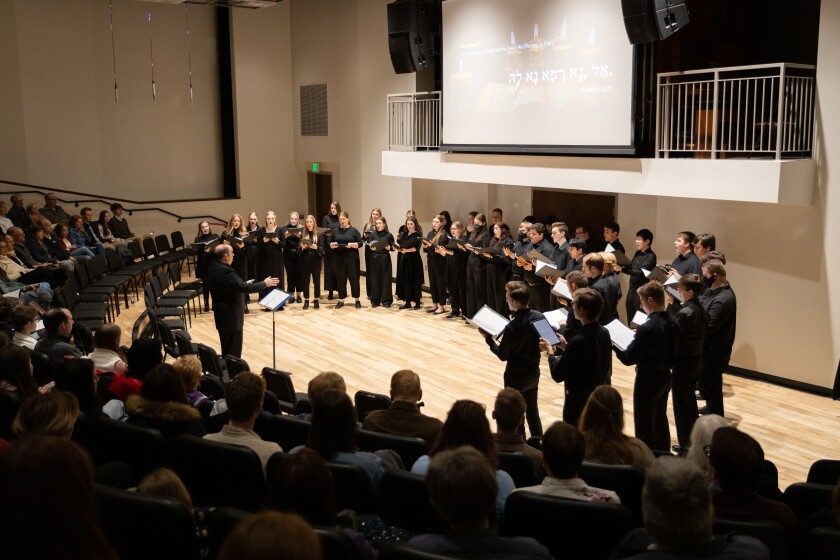Science Meets Art as BYU Singers Premiere Yuval Ron’s “Heal Me - a Song Cycle for A Cappella Choir @ 40Hz,” Host Panel Discussion with Leading Music and Science Scholars

Students from BYU’s School of Music had the unique opportunity to learn from Grammy-nominated world music artist Yuval Ron. His focus, along with colleague Richard Gold, is the effect that music at 40 Hertz (Hz) has on brain health and well-being.
Their research came to life on January 19, 2024, as BYU Singers premiered Ron’s new work “Heal Me - a Song Cycle for A Cappella Choir @ 40Hz.” The work is composed of Hebrew lyrics from Biblical healing prayers.
The School of Music also held a panel discussion with Ron, Gold and other BYU scholars where students could learn more about the research and ask questions. Panel members included Jeremy Yorgason (School of Family Life), Byron Adams (Biology), Garrett Cardon (Neuroscience), Andrew Crane (School of Music), Robert Brandt (School of Music), Steve Peck (Biology) and Rick Baldassin (School of Music). Crane and Brandt gave a piano and voice performance of Ron’s work to demonstrate music at 40Hz as part of the panel.
Ron and Gold’s research focuses on brain entrainment or any practice that purposefully aims to cause brainwave frequencies to fall into step with a stimulus (for example, music) that has a frequency corresponding to the desired brain-state. Gamma waves, which are responsible for cognitive function, are created when large populations of neurons fire together in a coordinated manner in the brain. Research from Massachusetts Institute for Technology (MIT) has brought to light the benefits that 40Hz gamma waves have on the brain. 40Hz waves are known to increase focus and attention, reduce the risk of neurodegenerative diseases, promote healing from brain trauma and improve both mood and sleep.

Doctors and researchers have previously used flashing light or a single tone sound to get patients to experience 40Hz waves. Although the patients were benefitting from the practice, it didn’t create an enjoyable experience. Gold and Ron created music at 40Hz with the same benefits as the flashing light or single tone but is much more enjoyable and accessible for people. They discovered that world music instruments, such as the sitar, can be tuned to play at 40Hz. They further discovered that on a piano the optimal 40Hz note is found between E one and E flat one. When tuned a quarter lower, a piano can then achieve 40Hz. Ron composed both world music and jazz music in 40Hz and co-produced two albums with Gold. The work was produced and published by Metta Mindfulness Music.
Ron found that music at 40Hz was not only healing to the recipients but also to the musicians who played it. He said, “The musicians were delighted to know their own instruments like they never had before. The sound was a whole new experience for them because the strings had a looser feel. [The instruments] had a warmer, mellower, darker and more melodic sound than normal tuning.”
Not everyone has embraced Ron’s tuning methods. He was hard pressed to find anyone willing to tune a piano a quarter lower to play music in 40Hz. The only person willing to do it was Rick Baldassin, an expert piano tuner at BYU whom Crane introduced to Ron. At the time of its tuning, BYU housed the only piano in the world tuned to play music at 40Hz.
Ron was drawn to the BYU School of Music for more than just Baldassin’s expertise. He said, “[I was] led to Brigham Young University because I heard recordings of the BYU Singers and I was really impressed with the quality of the singing—the spiritual quality—and the beauty of the voices.”

BYU Singers member Blake Wayment had the opportunity to work with Ron in preparation for the debut of “Heal Me - a Song Cycle for A Cappella Choir @ 40Hz.” The Singers were sent the music during the first week of winter semester. They learned and rehearsed the music and then performed it only two weeks later. They recorded the music in the Music Building Recital Hall before the performance.
This recording session was the first time Ron had heard this music sung. Wayment said, “It was unique that we were able to give the composer the first listen to his original score.”
Wayment noted that although the sound of the music was jazzy, the lyrics were pulled from Old Testament texts. “It was meaningful to know that a Jewish composer wrote this and although we come from different religions, we have a common belief in God and in miracles,” he said. “We were singing texts that we both believe in despite our differences.”
The best part of the entire experience for Wayment was knowing that the music he was singing was helping people. He said, “It was great to see how the audience reacted. I could see their faces light up when we sang. The main takeaway I had during this experience is that there are so many different aspects of music and it can be used in so many different ways. It was meaningful to be a part of a project that was meant to heal people.”